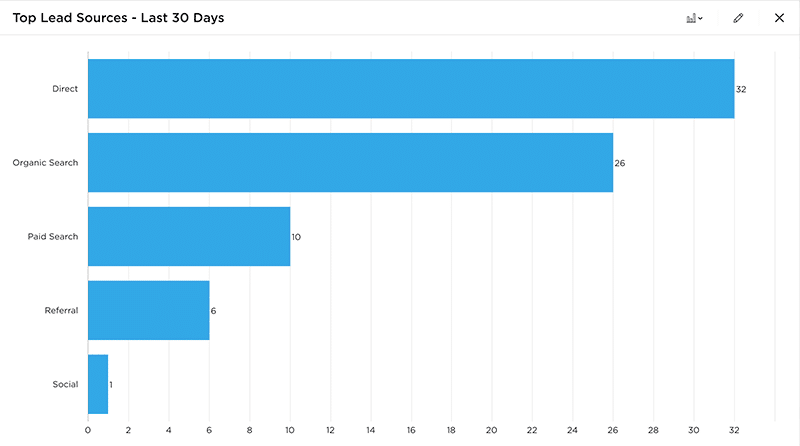Within the marketing trenches of most companies, a great deal of time, effort, passion, and drive is dedicated to producing content. So when that content falls flat, it’s easy to get disillusioned. You have expectations related to creating high-quality content assets that will resonate with buyers. You’ve set goals and expect a return on the investment. But sometimes, even the best content operation doesn’t generate traffic, leads, or conversions.
So what do you do in these moments? Well, you could just go with your gut and try something else. Or, you could dig deep into your performance data to glean insights specific to what IS working. It’s time for a content analytics deep dive.
Content Analytics: Metrics That Matter
There are a variety of ways to measure the effectiveness of content. Some are more fruitful than others. To get the most insight from content analytics, you need two things to start: a central hub that aggregates performance data from multiple sources and a clear idea of the metrics that matter.
Implementing something like a content marketing software platform with integrated content analytics brings more visibility so your team can see (in real time) what’s working. Easy access to a dashboard with all your most important data enables teams to make decisions faster and adjust plans on the fly.
So, what metrics are most valuable in discerning your highest performing formats, topics, and channels? Consider these metrics:
Referral source: where do users who visit your site come from? If you see high numbers from specific social media profiles then that’s where your audience is seeking information. Or, if your referral is high from specific channels like paid search or organic traffic, you know that users rely more on search engines.
Site engagement: which pages are most visited by users? Understanding which pages have the highest views offers significant insights on the topics and formats that your audience prefers. Also, look not just at which pages have the highest views but also time spent on those pages. This information provides context. If a page is highly visited, but only for brief periods, this means it probably needs work.
Social media return on investment: how engaged are your followers? Defining which social media channels you should optimize starts here. These engagement numbers also offer you critical information on the topics they prefer, as well.
Content Format Analysis
Smart and savvy content marketing teams develop a content strategy that considers a wide variety of content formats. That strategy is often driven by past results, as well as external factors like industry and buyer characteristics.
For example, if your target market has scarce time to research possible solutions to their challenges—think of time-pressed operations like healthcare or finance—you may find that long-form content initiatives just don’t ever gain traction. Instead, short, tightly focused blog posts, quick explainer videos, or infographics may kill it.
When deciphering the content format preferences of your audience, look at these metrics:
- Most shared content – if it was shared, it probably resonated, so make note of the format
- Most downloads – among your gated assets, which formats are getting the most downloads
- Highest converting landing page – which types of assets are you promoting on your highest performing landing page(s)
- Page views by type of content – many companies have a dedicated “resources” area on their website organized by content types/formats. Which are getting the most traffic?
With this information, you should be able to create a pie chart of content formats favored by your buyers. Take this information and go back to your content plan and make tweaks. If eBooks are popular, consolidate several blogs on the topic into one—a great repurposing idea!
Look for opportunities to use the most desired content formats, no matter the topic. If you can write a blog about it, you can make it into a video, and vice versa.
Content Topic Analysis
Defining which topics your audience prefers is fairly similar to the content format analysis. You’ll probably use similar processes and tracking methods to drill into the most shared content topics, downloads, conversions, and page views. But in many cases, the number of topics your team covers could be very large. Certainly much larger than the number of formats you produce. This may require more technological firepower.
So let’s look at a specific method for analyzing which topics perform the best within a specific content property: a blog. Getting this set up will require some technical prowess and access to your analytics tracking applications (namely Google Analytics and Google Tag Manager), but the video below by Stela Yordanova does a nice job of walking through the process.
As you can see from the video, the resulting report will clearly show which blog categories are most popular, which should aid in your future content strategy and planning efforts.
Another unique aspect of doing a thorough content topic analysis is that you need to also look outside your own data. You can use third-party tools and resources to measure what’s trending in your industry. Try a variety of content resources that can provide you with insights on what’s popular to your readers, including:
- Search engine volume for specific keywords (Google Trends, Keyword Planner, etc.)
- Topical research/monitoring platforms (Buzzsumo, ahrefs, etc.)
- Industry publications that have a pulse on what’s happening in the industry
- Feedback from your clients
Topic preferences will probably change the most, more than preferences for formats or channels. This is especially true if you work in a fast-changing industry or a highly regulated one. Staying on top of industry news and trends is central in getting topics right for your audience.
Content Channel Analysis
You probably use a variety of content marketing channels to reach your audience. Some return better results than others. But it’s not so black and white. Format and topics influence the channel you use. For example, if videos perform very well, then YouTube may be a high-returning channel for you, but it’s limited by format.
Some channels allow you to share almost any type of content. In these format-agnostic channels, you’ll probably have a more accurate read on the channels that offer the most connection and engagement.
Channels can also be very dependent on your audience type. If you have a physical product and rely heavily on visuals, then Instagram is an ideal social channel. However, if you work in the services industry and are strictly B2B, LinkedIn may be more optimal to reach your audience.
All that aside, the key to a channel-based analysis is to (again) determine which type of metric is most important to you. Do you just want to know which channel is delivering the most traffic? Or do you desire to go deeper to understand which channel has the highest conversion volume/rate (example below)? In most cases, quality trumps quantity.
Take a Breath
I know I just threw a lot at you, so take a quick breath. We see all too often marketers who are amazing content producers, but the analytics side of the process leaves them gasping for air. Just know that implementing the necessary tracking tools and doing this analysis regularly will help you better understand your buyers’ preferences and drive results.
However, keep in mind, their preferences can change quickly. Content formats, topics, and channels aren’t set in stone. They can always pivot. So, you need to be prepared. You can do a content analytics deep dive with DivvyHQ, a content marketing software platform built to serve all the needs of a content team. Schedule a quick demo today.

